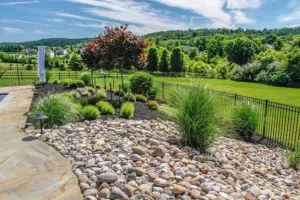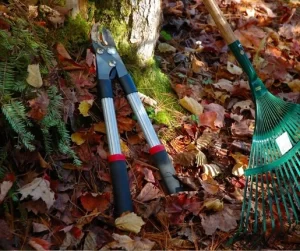Tree installation is a pivotal landscaping decision that shapes the look, health, and value of your outdoor space for decades. While many homeowners consider planting trees in spring or early summer, fall stands out as the ideal season for installing trees of all kinds.
The combination of cooler temperatures, increased soil moisture, and longer root establishment periods offers several benefits that other seasons can’t match. Whether you’re refining your landscaping design or exploring new landscaping ideas, understanding why fall is the best season for tree installation can guide you to a thriving and beautiful landscape.
In this detailed guide, we’ll explore the top reasons fall surpasses other seasons for tree planting, how to select and install trees properly, and practical landscaping tips to maximize your yard’s beauty and ecological health.

Advantages of Fall Tree Installation Over Other Seasons
1. Optimal Weather Conditions for Root Development
Fall brings cooler air temperatures while the soil remains warm—an ideal combination for root growth. With less heat stress and ample moisture, newly planted trees focus on establishing deep, expansive root systems, helping them anchor firmly and absorb more nutrients before winter dormancy.
This naturally favorable environment reduces transplant shock because the tree’s energy isn’t divided between foliage and new roots. Instead, it can concentrate on root development, giving the tree a strong foundation and a head-start for robust growth in spring.
2. Reduced Watering Requirements
Fall provides optimal conditions for healthy tree installation. Cooler air paired with warm soil promotes strong root development, allowing trees to establish deep, resilient roots before winter sets in. Since trees experience less heat stress, they can focus energy on growing a stable root system instead of maintaining foliage.
Additionally, reduced watering requirements make fall an even more efficient time for planting. With natural rainfall and lower evaporation rates, newly planted trees need less supplemental watering—minimizing the risk of water stress while helping them adapt smoothly to their new environment. This balance of moisture and temperature ensures trees are well-prepared to thrive once spring arrives.
3. Energy Conservation for the Tree
Fall provides the perfect conditions for successful tree installation. The season’s cooler air and warm soil promote optimal root development, allowing trees to establish strong foundations before winter. Without the stress of summer heat or the need to support new foliage, trees can conserve energy and focus on root growth. This energy-efficient phase strengthens their base, preparing them for vigorous growth once spring arrives.
Moreover, reduced watering requirements make fall planting even more practical. Natural rainfall and lower evaporation rates lessen the need for supplemental watering, minimizing water stress and helping trees adapt smoothly to their new environment. With balanced moisture, mild weather, and focused root development, fall tree installation ensures long-term health and stability for your landscape.
4. Less Competition From Weeds and Lawn
Fall offers the perfect opportunity for tree installation due to its mild temperatures and ideal soil conditions. Cooler air and warm soil encourage strong root development, while reduced plant activity allows trees to establish themselves without the stress of heat or drought. Additionally, fewer competing growth demands mean trees can focus their energy on building healthy root systems, ensuring they’re well-prepared for vigorous growth in spring.
Another advantage of fall planting is the reduced competition from weeds and lawn. During this season, aggressive weeds are less active, giving new trees better access to nutrients and moisture. By preparing the soil and adding mulch, you create a nutrient-rich, stable environment that supports healthy root growth and long-term tree vitality.
5. Extended Establishment Time Before Summer Stress
Fall is one of the best times for tree installation because it offers mild weather, balanced moisture, and the perfect environment for root establishment. With cooler air and warm soil, trees can focus their energy on developing strong root systems rather than supporting new foliage. This root-focused growth period helps them become more resilient and better prepared for the changing seasons ahead.
Another major benefit is the extended establishment time before summer stress. Trees planted in fall have several months to settle and develop roots before the intense heat of summer arrives. This early start reduces transplant shock, promotes better nutrient absorption, and ensures your trees are healthier and more stable when temperatures rise.
How Fall Tree Planting Fits Into Landscaping Design
Thousands of landscaping ideas incorporate trees as essential structural or focal elements. Fall planting supports those design goals by:
- Enhancing Seasonal Interest: Plant deciduous trees that show vibrant fall colors or evergreens that maintain winter greenery.
- Creating Functional Spaces: Trees planted early in fall provide shade for outdoor seating areas or privacy screens by the next summer.
- Supporting Wildlife: Native tree species installed in fall offer food and shelter to local birds and pollinators.
- Improving Curb Appeal: Strategically placed trees enhance the overall harmony and balance of your landscaping design.
Fall plantings align perfectly with well-thought-out site plans, maximizing long-term growth and visual impact.
Step-by-Step Guide to Fall Tree Installation
Step 1: Choose the Right Tree Species
Select trees suited to your climate, soil type, and landscape goals. Consider native species for easier maintenance and better ecological benefits. Popular fall choices include maples, oaks, dogwoods, and pines for evergreens.
Step 2: Pick a Healthy Tree
Inspect root balls for firmness and absence of disease. Check that the tree is balanced and free from broken branches.
Step 3: Plan the Location According to Landscaping Design
Evaluate sunlight, soil drainage, overhead power lines, and proximity to buildings. Ensure enough space for mature growth without interference.
Step 4: Prepare the Planting Site
Dig a hole twice the width of the root ball but only as deep as the root system. Loosen soil around the edges to encourage root spread.
Step 5: Plant Properly
Place the tree in the hole with the root flare slightly above ground level. Backfill gently, avoiding air pockets, and water thoroughly.
Step 6: Mulch Around the Base
Apply 2-3 inches of organic mulch to retain moisture and regulate soil temperature, keeping it a few inches away from the trunk.
Step 7: Water and Monitor
Even with fall rains, establish a regular watering schedule to support roots during dry spells. Monitor tree health through fall and winter, looking for signs of stress.
Landscaping Ideas to Complement New Trees
After planting, enhance your landscape with ideas that amplify tree beauty and function:
- Underplant with Shade-Tolerant Plants: Hostas, ferns, or native ground covers create lush, layered landscaping beneath trees.
- Install Landscaping Light: Highlight new trees with soft uplighting or surrounding path lights, boosting evening ambiance and safety.
- Add Seating or Decorative Features: Benches, garden sculptures, or birdbaths near trees invite relaxation and attract wildlife.
- Design Seasonal Color Themes: Plan complementary flower beds around tree base with fall blooms like mums or spring bulbs.
These ideas create inviting, multifaceted outdoor spaces that reflect a cohesive landscaping design.
Benefits of Professional Tree Installation in Fall
Hiring a professional service for fall tree installation can offer:
- Precise site evaluation and species recommendations
- Safe, equipment-assisted planting
- Knowledge of local soil and climate conditions
- Post-planting care plans and maintenance
Professionals ensure your trees get the best start, integrating seamlessly into your landscaping design for years to come.
Common Challenges When Planting Trees in Other Seasons
Understanding why fall excels means recognizing pitfalls in other seasons:
Season | Challenges |
Spring | Risk of drought; competing spring growth demands; potential frost damage after planting |
Summer | High water needs; heat stress; slower root growth |
Winter | Frozen ground; dormancy limits root growth and establishment |
Unlike these, fall combines ideal moisture, temperature, and growth cycles for trees.
Preparing Your Yard for Fall Tree Installation
To get ready, clean up the planting area and soil, removing debris and fallen leaves to reduce pests and diseases. Consider soil testing to optimize pH and nutrients. Integrate your tree planting into any larger landscaping design or ideas you have planned, such as creating shade or windbreaks.
Long-Term Care After Fall Planting
Post-installation care extends beyond planting day:
- Continue watering during dry periods.
- Monitor for pests and diseases.
- Staking young trees if windy conditions exist.
- Fertilizing in late winter or early spring for growth support.
- Annual inspections to prune damaged or crossing branches.
These habits ensure your fall-planted trees mature into impactful landscape assets.
Conclusion: Plant Trees in Fall for a Resilient, Beautiful Landscape
Planting trees during fall unlocks significant advantages over other seasons. From superior root development and reduced watering stress to ideal landscaping design integration, fall delivers the best foundation for thriving trees. By choosing the right species, following correct planting techniques, and incorporating creative landscaping ideas, you set the stage for an inviting, healthy outdoor space year-round.
Embrace the season’s conditions and plan your tree installation this fall to transform your yard into a living masterpiece that grows stronger with time.
Ready to Plant Your Dream Trees This Fall?
Don’t miss the prime window for tree installation this fall. Trust Hawkins Landscaping Inc., a family-owned company serving Frederick County and surrounding areas since 1974, to bring your landscaping ideas to life with expert tree planting, custom landscape design, and seasonal outdoor care. Our experienced team can help you choose the right tree species, plan your layout, and create a balanced landscape that thrives year after year.
Whether you’re enhancing your yard with new trees, upgrading your outdoor lighting, or exploring creative landscaping with rock ideas, Hawkins Landscaping delivers lasting beauty and professional results you can count on.
Start your tree journey today—call (301) 898-3615 or visit www.hawkinslandscaping.com to schedule your fall tree installation and watch your landscape flourish for years to come.




